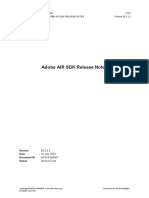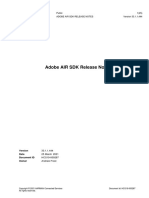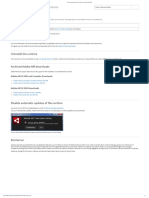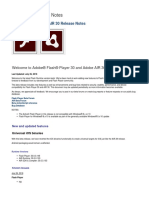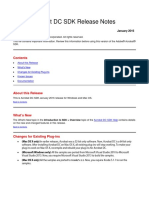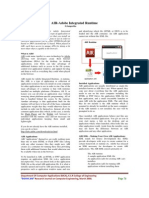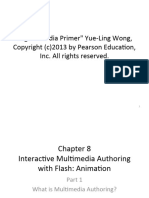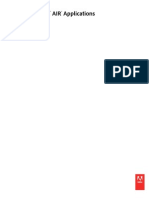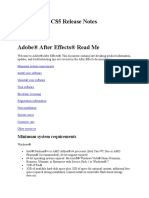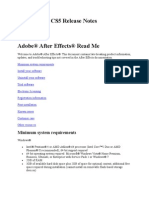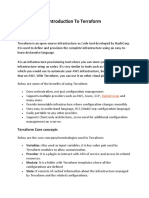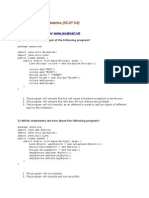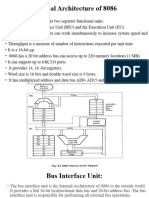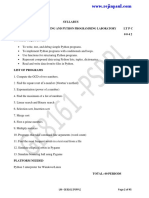Release Notes AIR SDK 51.1.3
Uploaded by
JamesRelease Notes AIR SDK 51.1.3
Uploaded by
JamesPublic 1(30)
ADOBE AIR SDK RELEASE NOTES Version 51.1.3.4
Adobe AIR SDK Release Notes
Version 51.1.3.4
Date 11 January 2025
Document ID HCS19-000287
Owner Andrew Frost
Copyright © 2024 HARMAN Connected Services Document Id: HCS19-000287
All rights reserved.
Public 2(30)
ADOBE AIR SDK RELEASE NOTES Version 51.1.3.4
Table of contents
1 Release Overview ............................................................................ 3
1.1 Key changes ...................................................................................... 3
1.2 Deployment ........................................................................................ 3
1.3 Limitations .......................................................................................... 4
1.4 Feedback ........................................................................................... 4
1.5 Notes ................................................................................................. 4
2 Release Information ......................................................................... 5
2.1 Delivery Method ................................................................................. 5
2.2 The Content of the Release ............................................................... 5
2.3 AIR for Linux – Restrictions................................................................ 6
2.4 AIR for Flex users .............................................................................. 6
3 Summary of changes ....................................................................... 7
3.1 Runtime and namespace version....................................................... 7
3.2 Build Tools ......................................................................................... 7
3.3 AS3 APIs............................................................................................ 7
3.4 Features ............................................................................................. 7
3.5 Bug Fixes ........................................................................................... 9
4 Configuration File .......................................................................... 16
5 Android builds................................................................................ 18
5.1 AAB Target ...................................................................................... 18
5.2 Play Asset Delivery .......................................................................... 18
5.3 Android Text Rendering ................................................................... 19
5.4 Android File System Access ............................................................ 20
6 Windows builds.............................................................................. 22
7 MacOS builds ................................................................................. 23
8 iOS support .................................................................................... 24
8.1 32-bit vs 64-bit ................................................................................. 24
8.2 MacOS remote linking from Windows .............................................. 24
9 Splash Screens .............................................................................. 27
9.1 Desktop (Windows/macOS) ............................................................. 27
9.2 Android ............................................................................................ 27
9.3 iOS ................................................................................................... 27
10 AIR Diagnostics ............................................................................. 28
10.1 Purpose ........................................................................................... 28
10.2 Mechanism....................................................................................... 28
10.3 Categories........................................................................................ 28
10.4 Diagnostic API and guide ................................................................. 29
10.5 FAQs ................................................................................................ 29
Copyright © 2024 HARMAN Connected Services Document Id: HCS19-000287
All rights reserved.
Public 3(30)
ADOBE AIR SDK RELEASE NOTES Version 51.1.3.4
1 Release Overview
Release 51.1.3.1 includes a number of feature updates for AIR 51.1, none of which require changes
to the ActionScript APIs or the XML application descriptor file format. It also includes some bug fixes
to further improve the stability and behaviour of the AIR runtime.
Release 51.1.3.2 is a bug fix release with a small number of updates, displayed here in a dark red
font.
Release 51.1.3.3 is another bug fix release with updates displayed in a blue font.
Release 51.1.3.4 is a minor update for Windows and macOS platforms, with changes displayed in a
green font.
1.1 Key changes
An additional feature which is targeted at the use of Android on PC-style devices is the support for
middle and right mouse events on that platform. Both Android and iOS now have support for UI
activity detection via the NativeApplication ‘userIdle’ and ‘userPresent’ event mechanism.
To aid in debugging and troubleshooting, we have also added enhanced debug output from the
runtime when some activities such as runtime/app installations or platform conversion (for ‘bundle’
creation) are happening. These can currently only be detected via a separate utility app, but the
intention is to add this also into the AIR SDK Manager.
Continuing the troubleshooting approach, another new feature is an internal set of ‘diagnostics’
capabilities which will allow applications to find out more details about the behaviour of the AIR
runtime under certain scenarios. Initially this is focused on helping to find problems with garbage
collection and also with ANRs on Android. Further details are found in section 10, and we expect to
add further capabilities to this mechanism to help applications to self-report issues.
Bug fixes include a better (and more extensive) fix for the iOS 18 fallback font problems, a problem
with navigateToURL on iOS 18, and Android updates to reduce ANRs as well as to remove a CPU
usage issue on ARMv7 devices.
Bug fixes in 51.1.3.2 can be found in section 3.5.2.
Bug fixes in 51.1.3.3 can be found in section 3.5.3.
Release 51.1.3.4 includes a fix to handle a video seek within a metadata callback, plus a fix for
StageWebView window handling on Windows platforms – see section 3.5.4.
1.2 Deployment
To obtain the release, it is recommended that developers install the AIR SDK Manager.
NOTE: it is likely that we will remove the monolithic zip files from the https://airsdk.harman.com
website at some point, and require all downloads to happen via the AIR SDK Manager. This is to
address some misuse of the website and to try to prevent some breaches of the license agreement.
The AIR SDK Manager is helping us publish minor updates/fixes with a quicker cadence without
resulting in a large amount of effort and data downloads.It is now available from the https://airsdk.dev
website, as part of the “getting started” instructions, or directly from github at:
https://github.com/airsdk/airsdkmanager-releases
Copyright © 2024 HARMAN Connected Services Document Id: HCS19-000287
All rights reserved.
Public 4(30)
ADOBE AIR SDK RELEASE NOTES Version 51.1.3.4
1.3 Limitations
For macOS users on 10.15+, the SDK may not work properly unless the quarantine setting is
removed from the SDK: $ xattr -d -r com.apple.quarantine /path/to/SDK
Please note that there is no longer support for 32-bit IPA files, all IPAs will use just 64-bit binaries now
so older iPhones/iPads may not be supported.
Android development should now be performed with an installation of Android Studio and the SDK
and build tools, so that the new build mechanism (using Gradle and the Android Gradle Plug-in) can
use the same set-up as Android Studio.
Linux runtimes are built using Ubuntu 16 for x86_64 variants in order to provide maximum
compatibility; however for arm64, the build environment uses Ubuntu 22 which then restricts usage to
similar versions of Linux (i.e. that have glibc version 2.34 or later).
1.4 Feedback
Any issues found with the SDK should be reported to adobe.support@harman.com or preferably
raised on https://github.com/airsdk/Adobe-Runtime-Support/issues.
The website for AIR SDK is available at: https://airsdk.harman.com with the developer portal available
under https://airsdk.dev
1.5 Notes
Contributors to the https://airsdk.dev website would be very welcomed: this portal is being built up as
the repository of knowledge for AIR and will be taking over from Adobe’s developer websites
The AS3 documentation for AIR is updated and now also available under this site:
https://airsdk.dev/reference/actionscript/3.0/
We will continue to provide the shared AIR runtime for Windows/macOS; however, this is not a
recommended deployment mechanism, it is prefereably to create native installers based on the
”bundle” deployments.
On MacOS in particular, the use of the shared AIR runtime to ‘install’ a .air file will not create a signed
application, hence new MacOS versions may block these from running. To ensure a properly signed
MacOS application is created, the “bundle” option should be used with native code-signing options
(i.e. those appearing after the “-target bundle” option) having a KeychainStore type with the alias
being the full certificate name.
Copyright © 2024 HARMAN Connected Services Document Id: HCS19-000287
All rights reserved.
Public 5(30)
ADOBE AIR SDK RELEASE NOTES Version 51.1.3.4
2 Release Information
2.1 Delivery Method
This release shall be delivered via the AIR SDK website: https://airsdk.harman.com/download
The update will also be available via the AIR SDK Manager. The latest version of this can be
downloaded from https://github.com/airsdk/airsdkmanager-releases/releases.
2.2 The Content of the Release
2.2.1 Detailed SW Content of the Release
Component Name 51.1.3.1 51.1.3.2 51.1.3.3 51.1.3.4
Core Tools 3.4.0 3.4.1 3.4.2
AIR Tools 3.1.0
Windows platform package 3.4.0 3.4.1 3.4.2 3.4.3
MacOS platform package 3.4.0 3.4.1 3.4.2 3.4.3
Linux platform package 3.4.0 3.4.1 3.4.2
Android platform package 3.4.0 3.4.1 3.4.2
iPhone platform package 3.4.0 3.4.1 3.4.2
2.2.2 Delivered Documentation
Title Document Number Version
Adobe AIR SDK Release Notes HCS19-000287 51.1.3
2.2.3 Build Environment
Platform Build Details
Android Target SDK Version: 34
Minimum SDK Version: 21
Platform Tools: 28.0.3
Build Tools: 34.0.0
SDK Platform: Android-34
Note – these are the versions we use to build the AIR SDK and runtime,
we also recommend developers match the same ‘target SDK’ version as
here.
iOS iPhoneOS SDK Version: 18.2
iPhoneSimulator SDK Version: 18.2
XCode Version: 16.2
Minimum iOS Target: 12.0
Copyright © 2024 HARMAN Connected Services Document Id: HCS19-000287
All rights reserved.
Public 6(30)
ADOBE AIR SDK RELEASE NOTES Version 51.1.3.4
tvOS tvOS SDK Version: 18.2
tvSimulator SDK Version: 18.2
XCode Version: 16.2
Minimum tvOS Target: 12.0
MacOS MacOS SDK Version: 15.2
XCode Version: 16.2
Minimum macOS Target: 10.13
Windows Visual Studio Version: 14.0.25431.01 Update 3
Linux GCC Version 5.4.0 (Ubuntu 16.04.1 – x86_64)
11.4.0 (Ubuntu 22.04.3 – arm64)
2.3 AIR for Linux – Restrictions
The AIR SDK now supports both x86_64 and arm64 based Linux platforms. These are only available
to developers with a commercial license to the SDK, and have some restrictions:
- No “shared runtime” support: applications would need to be built as ‘bundle’ packages with
the captive runtimes
- Packaging into native installers (“native” target type for .deb or .rpm files) is currently not
working: please create a “bundle” target and use Linux tools to distribute these
- No “StageWebView” component.
2.4 AIR for Flex users
HARMAN have continued Adobe’s strategy of issuing two AIR SDKs per platform: the first of these
(“AIRSDK_[os].zip”) contains the newer ActionScript compiler and is a full, self-contained SDK for
compiling and packaging AIR applications. The second of these is for combination with the Flex SDK
(“AIRSDK_Flex_[os].zip”) which doesn’t include a number of the files necessary for
ActionScript/MXML compilation. These SDKs should be extracted over the top of an existing, valid
Flex SDK.
The original instructions from Adobe are at https://helpx.adobe.com/uk/x-productkb/multi/how-overlay-
air-sdk-flex-sdk.html but a few alterations to this are needed to Step 4 if running on macOS. For this
platform, the downloaded AIR SDK zip needs to be expanded to a temporary area and then the copy
command needs to copy symbolic links as links rather than resolving them to files. This can be done
using a capital ’R’ rather than lowercase, hence:
cp -Rf /tmp/AIRSDK_Flex_MacOS/* /path-to-empty-FLEXSDK-directory
Please note that the config files (air-config.xml, airmobile-config.xml, flex-config.xml) may need to be
updated to support new features and updates in AIR or in dependencies such as ANEs. For example
to ensure the correct SWF version is output, the below line would need to be updated (e.g. to ‘50’ for
AIR 50.x, or ‘44’ for AIR 33.1, etc):
<swf-version>14</swf-version>
Copyright © 2024 HARMAN Connected Services Document Id: HCS19-000287
All rights reserved.
Public 7(30)
ADOBE AIR SDK RELEASE NOTES Version 51.1.3.4
3 Summary of changes
3.1 Runtime and namespace version
Namespace: 51.1
SWF version: 51
The namespace and SWF version updates are made across all platforms and may be used to access
the updated ActionScript APIs that have been introduced with AIR version 51.0. The namespace update
is required for opening any SWF file that’s got a SWF version of 51, or when using any of the new XML
application descriptor flags.
3.2 Build Tools
The Android build tools and platform used to create the AIR runtime files has been updated to
Android-34 with the default target SDK now set to this level in the generated Android manifest files.
Xcode 16.1 and the latest macOS and iphoneOS/tvOS SDKs are now being used to build the AIR
SDK. Please note when the update was made to use Xcode 15.0, the minimum iOS/tvOS target
version was increased to 12. Additional note: these are the versions that AIR itself is built with. The
versions shown in IPA files are manually injected by ADT and don’t (yet) take the version codes from
the local build environment. See Issue #3030 (github.com).
The build system for this is on a version of macOS that doesn’t support 32-bit processes hence we
cannot generate the 32-bit versions of the stub files. This means that we can no longer support older
32-bit iPhone/iPad devices.
3.3 AS3 APIs
No changes.
3.4 Features
Reference: AIR-7442
Title: AIR Android support for middle and right mouse button clicks
Applies to: Android runtime component
Description: For running Android on devices that support a physical mouse, this change
ensures that the MouseEvent.MIDDLE_CLICK and
MouseEvent.RIGHT_CLICK events are sent to a listener.
Reference: AIR-7457, AIR-7469
Copyright © 2024 HARMAN Connected Services Document Id: HCS19-000287
All rights reserved.
Public 8(30)
ADOBE AIR SDK RELEASE NOTES Version 51.1.3.4
Title: AIR Diagnostics – framework, long funcs, GC activity
Applies to: All runtime components
Description: An initial framework has been added into AIR to help in diagnostics, allowing
applications to get insights into how their functionality may be working on a
device. The initial implementation covers two features: (a) long-running
internal functions (i.e. if a frame’s AS3 processing or rendering code takes
too long, or if particular GC operations take a long time) which is intended to
help in particularly with Android ANR issues; and (b) the GC operations so
that you can check the timings of different operations, allowing apps to see
how frequently GC is triggered, how long is taken in the various phases, and
how much memory was cleaned up.
More details of this are added into a new section 10 below.
Reference: Github-108 https://github.com/airsdk/Adobe-Runtime-Support/issues/108
Title: Implementing NativeApplication userIdle/userPresent events for
mobile
Applies to: Mobile runtime components
Description: The “userIdle” and “userPresent” events were dispatched by the main
NativeApplication object only on desktop platforms. This update extends the
support to the mobile platforms so that applications can listen out for these
events to determine whether the user has interacted with the application
within a certain timeout period.
Reference: Github-3530 https://github.com/airsdk/Adobe-Runtime-Support/issues/3530
Title: Additional debugging during runtime installation and bundle
conversion
Applies to: Desktop runtime components
Description: A number of issues are sometimes raised regarding failures during the AIR
shared runtime installation process, or when installing a .air package, or
when creating a native application bundle. To help in debugging these
issues, we have added additional output to the runtime code where this is
being used, which will be dispatched to a LocalConnection pipe. This will
allow us to use the AIR SDK Manager to display troubleshooting details
(once this has been suitably updated).
As part of this change, an updated Win32 API has been added to perform file
operations where the earlier/deprecated API might fail.
Copyright © 2024 HARMAN Connected Services Document Id: HCS19-000287
All rights reserved.
Public 9(30)
ADOBE AIR SDK RELEASE NOTES Version 51.1.3.4
Reference: Github-3558 https://github.com/airsdk/Adobe-Runtime-Support/issues/3558
Title: Disabling Android Clipboard access if 'disableSensorAccess' is
set
Applies to: Android runtime component
Description: An earlier update was required to prevent the AIR runtime from checking for
orientation sensors, due to requirements from China regulators. This has
now expanded so that access to the system clipboard will also be disabled
when the ‘disableSensorAccess’ flag is set in the app descriptor file.
It is expected that the disabling of the clipboard service will move to have its
own XML app descriptor flag in the next dot-release i.e. in AIR 51.2.
3.5 Bug Fixes
3.5.1 Release 51.1.3.1
Reference: AIR- 7467
Title: Android AIR ANR caused by key listener in wrong thread
Applies to: Android runtime component
Description: Another set of ANR reports showed that a handler for a key listener was
being called on the main Android UI thread, but this then conflicted with the
AIR runtime when that had been running in a background thread. So the
handler calls for this have been shifted so that they are called on the runtime
thread.
Reference: Github-3521 https://github.com/airsdk/Adobe-Runtime-Support/issues/3521
Title: Reworking device text output to fix Chinese font issues
Applies to: iOS runtime component
Description: The initial fix made for this was to use a different (non-deprecated) API to
display the Chinese glyphs. However it was found this does not solve the
problem for all use cases, so more extensive change has been made which
switched from using CoreGraphics to CoreText to render the characters.
Copyright © 2024 HARMAN Connected Services Document Id: HCS19-000287
All rights reserved.
Public 10(30)
ADOBE AIR SDK RELEASE NOTES Version 51.1.3.4
Reference: Github-3536 https://github.com/airsdk/Adobe-Runtime-Support/issues/3536
Title: navigateToURL not working on iOS >= 18
Applies to: iOS runtime component
Description: The implementation of navigateToURL functionality on iOS had been using a
deprecated function, and in iOS 18 this turned into a no-op i.e. no longer did
anything. The code has been changed now to use a currently-lsupported
method.
Reference: Github-3583 https://github.com/airsdk/Adobe-Runtime-Support/issues/3583
Title: Android ARMv7 thread condition variable caused spinning CPU
Applies to: Android runtime component
Description: One of the condition variables set up in the thread handling for Android had
not been properly set up for 32-bit Android deployments. This issue was
introduced when the mechanism changed when updating to a newer compile
SDK version, in AIR 51.1, and caused the ‘wait’ operation to fail hence
sometimes resulting in the device ending up with high CPU and power
usage. This has been updated so that the variable initialisation is correctly
handled the same way as for the 64-bit code.
3.5.2 Release 51.1.3.2
Reference: AIR- 7483
Title: Android AIR crash in worker initialising sound channel
Applies to: All runtime components
Description: A crash log reported by a customer showed an issue with a null pointer
dereference within the AIR sound channel initialisation. This fix adds
defensive coding to a core (cross-platform) method within the runtime.
Reference: AIR- 7503
Title: Fixing crash in AIR iOS 'applicationDidReceiveMemoryWarning'
code
Copyright © 2024 HARMAN Connected Services Document Id: HCS19-000287
All rights reserved.
Public 11(30)
ADOBE AIR SDK RELEASE NOTES Version 51.1.3.4
Applies to: iOS runtime component
Description: An iOS test app crashed on startup, with the report showing an invalid
handling of the “memory warning” notification. This again required the
addition of some defensive programming to protect against the error
condition.
Reference: Github3530- https://github.com/airsdk/Adobe-Runtime-Support/issues/3530
Title: Updating AIR Win32 file operations to use IFileOperation with
message pump
Applies to: Windows runtime component
Description: File operations (move/copy/delete) on Windows had been using a
deprecated API which had been failing on some devices. The code has been
updated to use the newer APIs as a preference, and with the addition of a
message queue within the background thread on which the file operations
take place.
Reference: Github-3562 https://github.com/airsdk/Adobe-Runtime-Support/issues/3562
Title: Fixing code-signing of AIR app bundles on macOS
Applies to: Core build tools
Description: Native codesign commands had been run via the use of a “find” command to
ensure all frameworks within a bundle were signed. However, this could
result in problems when a framework contained another framework as these
need to be signed from the inside out to be valid. The ADT code has been
updated to use Java file methods to recurse into the folders and sign a
bundle from the inside out.
Reference: Github-3582 https://github.com/airsdk/Adobe-Runtime-Support/issues/3582
Title: Updating IPA constants for Xcode 16.2 iOS 18.2
Applies to: Core build tools
Copyright © 2024 HARMAN Connected Services Document Id: HCS19-000287
All rights reserved.
Public 12(30)
ADOBE AIR SDK RELEASE NOTES Version 51.1.3.4
Description: The constants used for IPA files (the Info.plist values, as well as the default
linker setting) have been updated to use Xcode 16.2 and the iPhoneOS /
AppleTVOS 18.2 version codes.
At the same time, a warning has been added in case a “-platformsdk”
argument has been provided for an iPhoneOS SDK during a build for a
simulator device, and vice versa.
Reference: Github-3591 https://github.com/airsdk/Adobe-Runtime-Support/issues/3591
Title: Ensuring Android StageText can capture a bitmap when running
in background mode
Applies to: Android runtime component
Description: The use of the AIR runtime in a background thread on Android means that a
bitmap of the StageText UI element cannot be captured from this thread.
This was causing problems for Starling/Feathers based text editor fields that
used StageText. However, it has been possible to add thread
synchronisation so that the UI thread can render the text to a bitmap whilst
the runtime thread waits for this.
Reference: Github-3595 https://github.com/airsdk/Adobe-Runtime-Support/issues/3595
Title: Fixing Android ANR in nativeSetVisible
Applies to: Android runtime component
Description: Another ANR being caused by the use of the AIR runtime in a background
thread, the visibility notifications from the OS were being passed directly into
the runtime whereas these should have been queued to be sent into the
runtime thread.
Reference: Github-3600 https://github.com/airsdk/Adobe-Runtime-Support/issues/3600
Title: Fixing alpha setting in text fields for iOS
Applies to: iOS runtime component
Description: As a result of the changes for Chinese font rendering, the alpha setting of a
TextField object was not being correctly applied to the text characters. This
has been fixed, and the alpha transform is also now being applied to any
background colour that is set on the TextField object (it was already being
applied to the border colour).
Copyright © 2024 HARMAN Connected Services Document Id: HCS19-000287
All rights reserved.
Public 13(30)
ADOBE AIR SDK RELEASE NOTES Version 51.1.3.4
Reference: Github-3604 https://github.com/airsdk/Adobe-Runtime-Support/issues/3604
Title: Fixing Android Banner mipmap image validation and location
Applies to: Core build tools
Description: Any multi-resolution Android TV banner object was being set up as a
mipmap resource, however the generated Android Manifest was referencing
a drawable resource with the same name, which resulted in the default AIR
banner image being used. This has been fixed, and validation has also been
added to ensure that the files that are referenced in the application descriptor
file for the banner images are present and correct.
3.5.3 Release 51.1.3.3
Reference: AIR- 7524
Title: Use of Screen.mainScreen in a Worker causes crash on iOS
Applies to: iOS runtime component
Description: Found by a customer with a settings class that used Screen.mainScreen
metrics within a static initialiser, the crash was caused by the use of this API
when running in a background thread; the code already had an execution
path that didn’t use the UIWindow API for prior iOS versions so this older
version is now being used when called from a background thread.
Reference: Github-2505- https://github.com/airsdk/Adobe-Runtime-Support/issues/2505
Title: Ensuring Windows video pipeline is drained if video finishes
before audio
Applies to: Windows runtime component
Description: A video file had been provided where a few seconds of audio continued after
the video packages had finished (i.e. the final frame stayed valid for 3s) but
the video decoder ‘drain’ request was only sent when AIR approached the
end of the overall stream. The code has been updated to also detect
separately when the video packet stream has run dry in order to switch the
decoder into ‘drain’ mode so that the last part of the content appears at the
correct time.
Copyright © 2024 HARMAN Connected Services Document Id: HCS19-000287
All rights reserved.
Public 14(30)
ADOBE AIR SDK RELEASE NOTES Version 51.1.3.4
Reference: Github-3478 https://github.com/airsdk/Adobe-Runtime-Support/issues/3478
Title: Fixing XML transformer exception when older namespace is used
Applies to: Core build tools
Description: An exception was thrown when creating an IPA file using the AIR 51.1 build
tools on an XML application descriptor file with an earlier namespace. This
was due to the inclusion of a new field in the Info.plist file that was then
missing from earlier application descriptor variants, resulting in a ‘null’ string
value that the XML transformer objected to. The correct default value has
now been implemented for where the namespace is 51.0 or earlier.
Reference: Github-3614 https://github.com/airsdk/Adobe-Runtime-Support/issues/3614
Title: Ensuring NetStream.Play.Complete is triggered from Windows
H.264 decoder
Applies to: Windows runtime component
Description: The newer H.264 decoder mechanism using the Windows media foundation
classes had not been properly triggering the “NetStream.Play.Complete”
callback method; this has been updated to match the earlier internal decoder
logic.
Reference: Github-3621 https://github.com/airsdk/Adobe-Runtime-Support/issues/3621
Title: Fixing crash in Win32 HTTP handling of zero-length responses
Applies to: Windows runtime component
Description: When an HTTP response was received, the response data was being
manually null-terminated in order to check the data format; however if there
was no data, the null terminator was being set on an invalid memory buffer
hence causing a segmentation fault. This condition is now checked to ensure
content handling is only applied when there is some content received.
Reference: Github-3625 https://github.com/airsdk/Adobe-Runtime-Support/issues/3625
Title: Preventing hang/crash in sound closure on Linux
Applies to: Linux runtime component
Copyright © 2024 HARMAN Connected Services Document Id: HCS19-000287
All rights reserved.
Public 15(30)
ADOBE AIR SDK RELEASE NOTES Version 51.1.3.4
Description: When using sound on Linux with a Worker running, if the application was quit
without first closing the worker (so that both workers terminated at the same
time) then the sound mechanism was being shut down twice due to a lack of
thread synchronisation. The shutdown code has now been put into a critical
section and the primordial worker will now close down the audio system with
any secondary workers finding that they do no need to do this.
3.5.4 Release 51.1.3.4
Reference: AIR- 7542
Title: Windows StageWebView fails if main window is destroyed
Applies to: Windows runtime component
Description: If a StageWebView object is created but not added to a stage, and the main
application window is destroyed, then the StageWebView creation failed.
This was due to the parenting of the webview window, which has now been
updated so that the parent of non-active StageWebView objects is a
separate window that won’t be destroyed if any NativeWindow is closed.
Reference: Github-2505- https://github.com/airsdk/Adobe-Runtime-Support/issues/2505
Title: Ensuring it's possible to seek(0) from a video metadata
callback
Applies to: Windows and macOS runtime components
Description: When a “seek(0)” was called from within a metadata callback, there was a
process hang which was caused by multiple threads trying to simultaneously
call into the same critical section, resulting in a deadlock. This has been fixed
along with a change to ensure the calls are not recursive (i.e. a “seek” that’s
called within a metadata callback should not trigger another metadata event).
Copyright © 2024 HARMAN Connected Services Document Id: HCS19-000287
All rights reserved.
Public 16(30)
ADOBE AIR SDK RELEASE NOTES Version 51.1.3.4
4 Configuration File
ADT uses an optional configuration file to change some of its behaviour. To create a configuration file
(there is not one by default within the SDK), create a new text file and save this with the name
“adt.cfg” in the SDK’s “lib” folder (i.e. alongside the ‘adt.jar’ file). The configuration file is in the
standard ‘ini file’ format with separate lines for each option, written as “setting=value”. Current options
are listed below:
Setting Explanation
DefaultArch Used as a default architecture if there is no “-arch”
parameter provided to ADT.
Values may be ‘armv8’, ‘armv8’, ‘x86’ or ‘x64’.
OverrideArch Used where an architecture value is being provided to ADT
using the ‘-arch’ parameter, this configuration setting will
override such parameter with the value given here.
Values may be ‘armv8’, ‘armv8’, ‘x86’ or ‘x64’.
DebugOut If set to “true”, results in additional output being generated
into a local file which can aid in debugging problems within
ADT (including the use of third party tools from the Android
SDK).
Values may be ‘true’ or ‘false’, default is ‘false’.
UncompressedExtensions A comma-separated list of file extensions that should not
be compressed when such files are found in the list of
assets to be packaged into the APK file.
For example: “UncompressedExtensions=jpg,wav”
AddAirToAppID Configures whether or not the “air.” prefix is added to an
application’s ID when it is packaged into the APK.
Values may be ‘true’ or ‘false’, default is ‘true’.
JavaXmx Adjusts the maximum heap size available to the Java
processes used when packaging Android apps (dx/d8, and
javac).
Default value is 1024m although this is automatically
overridden by any environment variable or value passed to
the originating application. If this config setting is present,
e.g. ‘2048m’, then it takes priority over all other
mechanisms.
CreateAndroidAppBundle Overrides any usage of ADT with an APK target type, and
instead generates an Android App Bundle. Note that the
output filename is not adjusted so this may result in
generation of a file with “.apk” extension even though it
contains an App Bundle.
Values may be ‘true’ or ‘false’, default is ‘false’.
Copyright © 2024 HARMAN Connected Services Document Id: HCS19-000287
All rights reserved.
Public 17(30)
ADOBE AIR SDK RELEASE NOTES Version 51.1.3.4
KeepAndroidStudioOutput When generating an Android App Bundle, rather than
using a temporary folder structure and cleaning this up,
this option will generate the Android Studio file structure
under the current folder and will leave this in place).
Values may be ‘true’ or ‘false’, default is ‘false’.
AndroidPlatformSDK A path to the Android SDK, that can be used instead of the
“-platformsdk” command line parameter. Note that on
Windows, the path should contain either double-
backslashes (“c:\\folder”) or forwardslashes (“c:/folder”).
iOSPlatformSDK A path to the iOS/iPhone/iPhoneSimulator SDK, that can
be used instead of the “-platformsdk” command line
parameter.
JAVA_HOME This can be set as an override or alternative to the system
environment variable that is read when ADT needs to use
Java (e.g. when creating an Android App Bundle). Note
that on Windows, the path should contain either double-
backslashes (“c:\\folder”) or forwardslashes (“c:/folder”).
UseNativeCodesign On macOS, this will mean that the IPA binary is signed
using the “codesign” process rather than using internal
Java sun security classes within ADT. This is “false” by
default, unless ADT detects that the sun security Java
classes are not available.
SignSwiftFiles By default, any swift libraries that are included in an IPA
payload are signed in the normal way. This can be turned
off by setting this value to “false”.
OnlyIncludeSwiftUsedArchsInSupport If this is set to “true” then for ipa-app-store builds that
include a “SwiftSupport” folder, the swift libraries will be
updated via lipo to only include architectures that are used
by the application (e.g. armv7 and arm64, omitting armv7s
and arm64e).
OnlyIncludeSwiftUsedArchsInPayload This is similar to the above flag but applies to the versions
of the swift libraries that are included in the “Payload”
folder within the IPA package. This (and the above) are
now defaulting to “false” so that the swift libraries are just
copied into position, but to get the legacy behaviour this
should be set to “true”.
iosSimulator The name of a simulator to use when installing or running
an IPA file on an iPhone simulator on mac. Note that this
value will be overridden by any command-line option or by
an environment variable should this be set as well (i.e.
AIR_IOS_SIMULATOR_DEVICE).
Copyright © 2024 HARMAN Connected Services Document Id: HCS19-000287
All rights reserved.
Public 18(30)
ADOBE AIR SDK RELEASE NOTES Version 51.1.3.4
5 Android builds
5.1 AAB Target
Google introduced a new format for packaging up the necessary files and resources for an application
intended for uploading to the Play Store, called the Android App Bundle. Information on this can be
found at https://developer.android.com/guide/app-bundle
AIR now supports the App Bundle by creating an Android Studio project folder structure and using
Gradle to build this. It requires an Android SDK to be present and for the path to this to be passed in
to ADT via the “-platformsdk” option (or set via a config file – it also checks in the default SDK
download location). It also needs to have a JDK present and available, and will attempt to find this
either from configuration files or via the JAVA_HOME environment variable (or if there is an Android
Studio installation present in the default location, using the JDK provided by that).
To generate an Android App Bundle file, the ADT syntax is similar to the “apk” usage:
adt -package -target aab <signing options> output.aab <app descriptor and files> [-extdir
<folder>] -platformsdk <path_to_android_sdk>
No “-arch” option can be provided, as the tool will automatically include all of the architecture types.
Signing options are optional for an App Bundle.
Note that the creation of an Android App Bundle involves a few steps and can take significantly longer
than creating an APK file. We recommend that APK generation is still used during development and
testing, and the AAB output can be used when packaging up an application for upload to the Play
Store.
ADT allows an AAB file to be installed onto a handset using the “-installApp” command, which
wraps up the necessary bundletool commands that generate an APKS file (that contains a set of APK
files suitable for a particular device) and then installs it. If developers want to do this manually,
instructions for this are available at https://developer.android.com/studio/command-
line/bundletool#deploy_with_bundletool, essentially the below lines can be used:
java -jar bundletool.jar build-apks --bundle output.aab --output output.apks --connected-
device
java -jar bundletool.jar install-apks --apks=output.apks
Note that the APK generation here will use a default/debug keystore; additional command-line
parameters can be used if the output APK needs to be signed with a particular certificate.
5.2 Play Asset Delivery
As part of an App Bundle, developers can create ”asset packs” that are delivered to devices
separately from the main application, via the Play Store. For information on these, please refer to the
below link:
https://developer.android.com/guide/playcore/asset-delivery
In order to create asset packs, the application XML file needs to be modified within the <android>
section, to list the asset packs and their delivery mechanism, and to tell ADT which of the files/folders
being packaged should be put into which asset pack.
For example:
<assetPacks>
Copyright © 2024 HARMAN Connected Services Document Id: HCS19-000287
All rights reserved.
Public 19(30)
ADOBE AIR SDK RELEASE NOTES Version 51.1.3.4
<assetPack id="ImageAssetPack" delivery="on-demand"
folder="AP_Images"/>
</assetPacks>
This instruction would mean that any file found in the ”AP_Images” folder would be redirected into an
asset pack with a name ”ImageAssetPack”. The delivery mechanisms can be ”on-demand”, ”fast-
follow” or ”install-time” per the Android specifications.
Note that assets should be placed directly into the asset pack folder as required, rather than adding
an additional ”src/main/assets” folder structure that the Android documentation requires. This folder
structure is created automatically by ADT during the creation of the Android App Bundle.
The asset pack folder needs to be provided as a normal part of the command line for the files that
should be included in a package. So for example if the asset pack folder was ”AP_Images” and this
was located in the root folder of your project, the command line would be:
adt -package -target aab MyBundle.aab application.xml MyApp.swf AP_Images
[then other files, -platformsdk directive, etc]
If there were a number of asset packs and all of the relevant folders were found under an
”AssetPacks” folder in the root of the project, the command line would be:
adt -package -target aab MyBundle.aab application.xml MyApp.swf -C
AssetsPacks . [then other files, -platformsdk directive, etc]
To access the asset packs via the Android Asset Pack Manager functionality, an ANE is available via
the AIR Package Manager tool. See https://github.com/airsdk/ANE-PlayAssetDelivery/wiki
5.3 Android Text Rendering
Previously, the rendering of text on Android had been handled via a native library built into the C++-
based AIR runtime file. This had some restrictions and issues with handling fonts, which caused major
problems with Android 12 when the font fallback mechanism was changed and the native code no
longer coped with this. To resovle this, a new text rendering mechanism has been implemented that
uses public Android APIs in order to set up the fonts and to render the text.
The new mechanism uses JNI to communicate between the AIR runtime and the Android graphics
classes for this, and has some differences with the legacy version. One of the changes that has been
made is to correct the display of non-colorized text elements when rendering to bitmap data: in earlier
builds, if some text included an emoji with a fixed color (e.g. ”flames” that are always yellow/orange
even if you request a green font color) then these characters appeared blue, due to the different pixel
formats used by Android vs the AIR BitmapData objects. With the new mechanism, AIR correctly
renders these characters to BitmapData (although the problem still remains when rendering device
text to a ’direct’ mode display list).
Some developers may not want to switch to this new mechanism yet, and others may want their
applications to always use it. Some would perhaps want it only when absolutely necessary i.e. from
Android 12 onwards. To cope with this request, there is a new application descriptor setting that can
be used: ”<newFontRenderingFromAPI>” which shoudl be placed within the <android> section of the
descriptor XML. The property of this can be used to set the API version on which the new rendering
mechanism takes place. The default value is API level 31 which corresponds to Android 12.0 (see
https://source.android.com/setup/start/build-numbers). So for example if you always want devices to
use the new mechanism, you can add:
<newFontRenderingFromAPI>0</newFontRenderingFromAPI>
whereas if you never want devices to use this, you could add:
<newFontRenderingFromAPI>99999</newFontRenderingFromAPI>
Copyright © 2024 HARMAN Connected Services Document Id: HCS19-000287
All rights reserved.
Public 20(30)
ADOBE AIR SDK RELEASE NOTES Version 51.1.3.4
5.4 Android File System Access
In the earlier versions of Android, it was possible to use the filesystem in a similar way to a Linux
computer, but with a set of restrictions that had a fairly high-level granularity:
- It was possible to read/write to an application’s private storage location. AIR exposes this via
”File.applicationStorageDirectory”.
- If the app requested the ’read/write storage’ permission, the app could then read and write in
the user’s shared storage location and to removable storage. The main home folder was
accessible via ”File.userDirectory” or ”File.documentsDirectory”, and later AIR
33.1 added ”File.applicationRemovableStorageDirectory”.
- Later, this was updated such that the user had to also grant permission via a system pop-up
message. To trigger this pop-up, AIR developers could use ”File.requestPermission()”
With the introduction of “scoped storage” however, a lot of this has changed. Android files are treated
in a similar way to other resources, with URLs using the “content://” schema which can refer either to
filesystem-backed files, or to transient resources, or elements within other storage mechanisms such
as databases and libraries. Permission to access each resource depends upon the creator of that
resource, and by default it’s not possible for an application to open a file that another application had
created. Permissions for the top-level internal storage (i.e. “File.documentsDirectory”) have
been changed so that applications cannot create entries here but must use sub-folders of these (a set
of standard sub-folders is generally created by the OS).
Within AIR, we have been attempting to add support for the “content://” URIs, and to switch the File
class “browseForXXX” functions so that they use the new intent-based mechanisms for selecting
files to open and save, or to select a folder. Within these calls, we are also requesting the appropriate
read/write permissions (and persisting these so that they can be used in the future). This means that it
should be possible to call “browseForOpen()” and allow the user to select a shared file that can
then always be opened (for reading). Equally a “browseForDirectory()” call should mean that an
application then has read/write access into the selected directory and its sub-tree.
Requesting file system permissions has to be handled in a similar way, with permissions either
granted for a file or for a folder tree. The “File.requestPermission()” function therefore looks at
the native path of the File object this is called on, and decides whether to show a file open intent (if
there’s a normal path or URL in the nativePath property), or to show a folder selection intent (if the
path ends in a forward-slash), or whether to just ignore the call with a ‘granted’ response and then
wait for later permission requests for individual files (if the File object has not had a nativePath set).
This last option is intended to allow apps to work across different Android versions and is the
recommended option: early in the application lifecycle, create a new File and call
requestPermissions(): if the app is running on an earlier Android version, the permission pop-up
will appear, otherwise the app will need to request specific file access later on via the
“browseForXXX” functions or by requesting permission for a specific file. Sadly it isn’t possible to
ensure that the user only gives a yes/no response for these file/folder open intents, they are able to
browse for other files, so it may be that the file the user selects is not the one you are trying to open. If
this is detected, the permission status event will show as ‘denied’, so if you are happy for the user to
choose a different file, use “browseForOpen()” rather than “requestPermission()”.
There is an exception to having to use scoped storage and the storage access framework, which is if
an application has the “MANAGE_EXTERNAL_FILES” permission. This permission is intended for
utilities such as file manager apps and anti-virus scanners that have a legitimate need to access all
the (shared storage) files on the device, but if an app requests this permission and is submitted to the
Play Store, but doesn’t justify itself, then the submission is likely to be rejected.
Some applications are not distributed via the Play Store though, at which point this permission can be
used to turn the behaviour back to how it used to be in earlier Android versions. The
Copyright © 2024 HARMAN Connected Services Document Id: HCS19-000287
All rights reserved.
Public 21(30)
ADOBE AIR SDK RELEASE NOTES Version 51.1.3.4
“File.requestPermission()” capability has been overridden in the cases where AIR detects this
permission has been requested in the manifest, and it will now display the appropriate dialog to ask
the user to turn on the ‘all files’ access for this app. Once this has been granted (asynchronously), it
would then be possible to create, read and write files and folders including in the root storage device.
Copyright © 2024 HARMAN Connected Services Document Id: HCS19-000287
All rights reserved.
Public 22(30)
ADOBE AIR SDK RELEASE NOTES Version 51.1.3.4
6 Windows builds
The SDK now includes support for Windows platforms, 32-bit and 64-bit. We recommend that
developers use the “bundle” option to create an output folder that contains the target application. This
needs to be packaged up using a third party installer mechanism, in order to provide something that
can be easily distributed to and installed by end users. HARMAN are looking at adapting the previous
AIR installer so that it would be possible for the AIR Developer Tool to perform this step, i.e. allowing
developers to create installation MSI files for Windows apps in a single step.
Instructions for creating bundle packages are at:
https://help.adobe.com/en_US/air/build/WSfffb011ac560372f709e16db131e43659b9-8000.html
Note that 64-bit applications can be created using the “-arch x64” command-line option, to be added
following the “-target bundle” option.
Copyright © 2024 HARMAN Connected Services Document Id: HCS19-000287
All rights reserved.
Public 23(30)
ADOBE AIR SDK RELEASE NOTES Version 51.1.3.4
7 MacOS builds
MacOS builds are provided only as 64-bit versions. A limited shared runtime option is being prepared
so that existing AIR applications can be used on Catalina, but the expectation for new/updated
applications is to also use the “bundle” option to distribute the runtime along with the application, as
per the above Windows section.
Note that Adobe’s AIR 32 SDK can be used on Catalina if the SDK is taken out of ‘quarantine’ status.
For instructions please see an online guide such as:
https://www.soccertutor.com/tacticsmanager/Resolve-Adobe-AIR-Error-on-MacOS-Catalina.pdf
AIR SDK now supports MacOS Big Sur including on the new ARM-based M1 hardware: applications
will be generated with ‘universal binaries’ and most of the SDK tools are now likewise built as
universal apps.
Copyright © 2024 HARMAN Connected Services Document Id: HCS19-000287
All rights reserved.
Public 24(30)
ADOBE AIR SDK RELEASE NOTES Version 51.1.3.4
8 iOS support
8.1 32-bit vs 64-bit
For deployment of AIR apps on iOS devices, the AIR Developer Tool will use the provided tools to
extract the ActionScript Byte Code from the SWF files, and compile this into machine code that is then
linked with the AIR runtime and embedded into the IPA file. The process of ahead-of-time compilation
depends upon a utility that has to run with the same processor address size as the target architecture:
hence to generate a 32-bit output file, it needs to run a 32-bit compilation process. This causes a
problem on MacOS Catalina where 32-bit binaries will not run.
Additionally, due to the generation of stub files from the iPhone SDK that are used in the linking
process – which are created in a similar, platform-specific way – it is not possible to create armv7-
based stub files when using Catalina or later. From release 33.1.1.620, the stub files are based on
iOS15 and are purely 64-bit. This means that no 32-bit IPAs can be generated, even when running on
older macOS versions or on Windows.
8.2 MacOS remote linking from Windows
Due to a number of updates from Apple around the mach-o linker, and the movement of symbols
between different component libraries, it has become increasingly problematic to link Apple binaries
on a Windows computer. Originally, Adobe had cross-compiled the “ld64” Apple linker, but without
support for the “TBD” format that Apple use for the iPhoneOS/AppleTVOS SDKs. To work around this
limitation, the AIR SDK includes “stub” binaries for the SDKs – but it is not then possible to support
the movement of symbols i.e. where a particular symbol is found in different frameworks for different
iOS versions.
Using LLVM’s linker, which supports the mach-o format, it was also found that Apple restrictions had
been preventing some applications from being published via the App Store due to a difference in how
symbols were found/stored, and the known/unsupported issues in LLVM meant that this is also not a
completely viable solution.
The solution that we will work with now is to use a mac machine to perform the link stage of the build
process. The rest of the development and build process can still occur on Windows but linking the AIR
application’s object files against the iPhone / AppleTV SDKs should be done on a mac.
There are two ways to achieve this: initially a manual mechanism to allow files to be pushed to a
macOS machine, linked via a script, and then the result copied back to the Windows machine where
the packaging command needs to be run again to pick up the binary. And with the release of 51.0.1
this is now possible to handle automatically within a single run of ADT, following some initial machine
configuration. Details on these two methods follow.
8.2.1 Manual copying and linking
There are a number of steps to the build process in this scenario.
1. Configure ADT to use a specific folder, into which all linker inputs will be placed.
To do this, edit the “adt.cfg” file (in your home folder under an “.airsdk” subfolder) and add a line:
“IPALinkFolder=c:/path/to/link/folder”. This must be the name of an existing folder, under
which subfolders will be created for each run of ADT. Note that you need to use forward-slashes, or
escaped backslashes (“\\”), due to how Java reads in property files.
2. Run your normal link command via ADT.
This will then generate a subfolder under your “IPALinkFolder” location, which contains a script file
and all the input files needed for the Apple linker.
Copyright © 2024 HARMAN Connected Services Document Id: HCS19-000287
All rights reserved.
Public 25(30)
ADOBE AIR SDK RELEASE NOTES Version 51.1.3.4
3. Copy this link folder to your macOS computer.
This can be done with SFTP/SCP or similar tools, or potentially you could have a network shared
folder set up.
4. On the macOS computer, run the linker.
Using a terminal window, you will first need to set an environment variable, “AIR_SDK_HOME”, and
then run the script that was generated by ADT. For example:
export AIR_SDK_HOME=/Users/username/Downloads/AIR_SDK/AIRSDK_51.0.1
./linkerscript.sh
5. Copy the resulting file back onto the Windows PC.
The file should be called “linkerOutput” and should be an arm64 macho executable file.
6. Call ADT again, this time providing the linked file.
To do this, add the arguments “-use-linker-output path_to_linkerOutput”; this can go
within the normal input files list, or at the end of this (similar to “-extdir”).
ADT will then ignore the normal command to link the binary, and will use the provided executable in
order to package and sign the IPA file.
7. Clean up.
The folder that’s created under the “IPALinkFolder” location, as well as the linkerOutput file (and of
course the files that have been copied to the macOS machine) are not automatically deleted. So
these should be periodically cleaned up manually to avoid wasting disk space.
8.2.2 Programmatic remote linking
In order to automatically allow the Windows machine to connect to the macOS machine and to copy
files and drive the linker, a password-less mechanism will need to be set up to allow remote access
without any user interaction. This requires the use of SSH keys: unless a key-pair is created that
doesn’t have a passphrase, it will be necessary to use “ssh-agent” to store the passphrase and
associate this with the user’s Windows credentials.
To set this up (one time only):
1. Create a new key-pair (unless you want to use an existing pair).
On Windows, run “ssh-keygen” and provide a filename – the default is “id_rsa” but in this
walkthrough we shall use “adt_access”. It then prompts for a passphrase: if you leave this blank, you
will not need to follow the “ssh agent” steps below, but the recommendation would be to create a
suitably secure passphrase for this. You should then have two files, “adt_access” and
“adt_access.pub”.
2. Install the public key on the mac machine.
You can use sftp/scp for this. The key should be added into your “.ssh” folder – note that you need the
username of the mac machine, which we shall assume is just “user”. You will then need to configure
SSH to allow this public key to be used for connections: if you remote in (or just open a terminal) on
the mac, go into the “.ssh” folder, and run: “cat adt_access.pub >> authorized_keys”. This
adds the new key onto the end of the authorized keys list.
3. Set up ssh agent to provide the passphrase.
Firstly you will need to check that ssh-agent is running: open “Services” on the computer, and find an
entry with name “OpenSSH Authentication Agent”. This should be changed to “Automatic”, or
“Automatic (Delayed Start)” if you prefer, and if necessary, also started manually. The “Status” column
should show that this is running.
Copyright © 2024 HARMAN Connected Services Document Id: HCS19-000287
All rights reserved.
Public 26(30)
ADOBE AIR SDK RELEASE NOTES Version 51.1.3.4
Then in a Windows console, run “ssh-add adt_access” and provide your passphrase.
Note that if you get an error message “Permissions for 'private-key.ppk' are too open”, you will need to
ensure that only the current user is able to access the private key file (“adt_access”). This means
adjusting the “Security” properties on this file, changing the owner of the file to the current local user
account, removing inheritance and inherited permissions, and removing all permissions for
users/groups other than the current local user. For more details, see the below link:
Windows SSH: Permissions for 'private-key' are too open - Super User
You can then test the connection by running “ssh -i adt_access user@mac_ip_address”,
which should then log on automatically without further prompting.
4. Provide the configuration to ADT.
Now that you have the connectivity set up, you need to create a configuration file for AIR. You will
need to add two entries into the “adt.cfg” file that is in your “c:\users\username\.airsdk\” folder:
IPALinkFolder=c:/path/to/link/folder
RemoteLinkMachine=mac_ip_address
The first setting is to provide a location into which the linker will output all of the files. This is not
strictly necessary but will aid in debugging problems.
The second provides the network location of the remote machine onto which you’ve put the public ssh
key.
You will then need to create a configuration file with the name of this “mac_ip_address” network
address, with an “.cfg” extension, and put this into a subfolder “remote_link_configs” under the .airsdk
directory. For example:
C:\Users\username\.airsdk\remote_link_configs\192.168.1.3.cfg
The contents of this file should be:
CertPath=C:/path/to/private/key/adt_access
Username=user
SdkFolder=/Users/user/Documents/AIR_SDKs/AIRSDK_51.0.1
The “CertPath” value points to the private key that we’ve named “adt_access”, again please note the
use of forward-slashes or double-backslashes in the Windows path. “Username” is the user
associated with the key from when this was added to “authorized_keys”. And “SdkFolder” is the path
on the remote mac machine where an AIR SDK can be found. This path is only used for the runtime
libraries i.e. “libRuntimeHMAOT.arm-air.a” and “builtin_abc.arm64-air.o”, the linker won’t use this for
the actual link binary (ld64) or the stub files; instead, the remote script picks up your iPhoneOS SDK
using the “xcrun” utility.
Once that is all set up, you can use ADT as normal for IPA builds, and the remote linking will happen
in the background. If there are issues, please check the adt.log (or use AIR SDK Manager’s
“Troubleshooting” tab) and report an issue via Github.
Please do note that the link folders are not (currently) cleaned up with this approach, so the location
under the “IPALinkFolder”, and its copy that is pushed to the remote Mac device (with the same
name, within the user’s home folder) will still exist after the ADT process has completed. This will help
with debugging any issues, but we expect to change this in the future.
Copyright © 2024 HARMAN Connected Services Document Id: HCS19-000287
All rights reserved.
Public 27(30)
ADOBE AIR SDK RELEASE NOTES Version 51.1.3.4
9 Splash Screens
For our ‘free tier’ users, a splash screen is injected into the start-up of the AIR process, displaying the
HARMAN and AIR logos for around 2 seconds whilst the start-up continues in the background. There
are different mechanisms used for this on different platforms, the current systems are described
below.
9.1 Desktop (Windows/macOS)
Splash screens are displayed in a separate window centred on the main display, while the start-up
continues behind these. The processing of ActionScript is delayed until after the splash screen has
been removed.
9.2 Android
The splash screen is displayed during start-up and happens immediately the runtime library has been
loaded. After a slight delay the initial SWF file is loaded in and when processing for this starts, the
splash screen is removed.
9.3 iOS
The splash screen is implemented as a launch storyboard with the binary storyboard and related
assets included in the SDK. This has implications for those who are providing their own storyboards or
images in an Assets.car file:
- If you are on the ‘free tier’ then the AIR developer tool will ignore any launch storyboard you
have specified within your application descriptor file, or provided within the file set for
packaging into the IPA file.
- If you are creating an Assets.car file, then you need to add in the AIR splash images from the
SDK which are in the “lib/aot/res” folder. These should be copied and pasted into your
“.xcassets” folder in the Xcode project that you are using for creation of your assets.
Troubleshooting:
Message from ADT: “Warning: free tier version of AIR SDK will use the HARMAN launch
storyboard” – this will be displayed if a <UILaunchStoryboardName> tag has been added via the
AIR application descriptor file. The tag will be ignored and the Storyboard from the SDK will be used
instead.
Message from ADT: “Warning: removing user-included storyboard "[name]"” will be displayed
if there was a Storyboardc file that had been included in the list of files to package: this will be
removed.
Message from ADT: "Warning: free tier version of AIR SDK must use the HARMAN launch
storyboard" – this will be displayed if the Storyboardc file in the SDK has been replaced by a user-
generated one.
If a white screen is shown during start-up: check that the HARMAN splash images are included in
your assets.car file. Note that the runtime may shut down if it doesn’t detect the appropriate splash
images.
The runtime may also shut down for customers with a commercial license if a storyboard has been
specified within the AIR descriptor file but not added via the list of files to package into the IPA file.
Copyright © 2024 HARMAN Connected Services Document Id: HCS19-000287
All rights reserved.
Public 28(30)
ADOBE AIR SDK RELEASE NOTES Version 51.1.3.4
10 AIR Diagnostics
10.1 Purpose
The goal of the AIR diagnostics implementation is to allow both developers and HARMAN to benefit
from additional metrics around an appication for debugging purposes. One of the key goals is to allow
errors that occur in the field to be detected and reported back, with an initial focus being around the
Android ”Application Not Responding” issues that are relatively common and can trigger the ’bad
behaviour’ labels from the Google Play Store.
There have also been a number of situations where HARMAN are unable to reproduce issues, and
where additional logging has been added to the AIR runtime for developers to then reproduce a
problem and report back. With the framework in place for AIR diagnostics, such logging could then
start using this mechanism, and could then be left in place and become part of the generic runtimes
rather than needing customer-specific builds.
10.2 Mechanism
Implementing a mechanism to capture diagnostics has to also consider the performance of the
runtime, as we do not want to significantly impact performance (or memory footprint) of the deployed
applications. It is important therefore that any checks as to whether a particular diagnostic should be
captured/reported should be as minimal as possible, and no processing of data specific to this should
occur if the relevant category of diagnostic has not been enabled.
Internally, we have used ANEs as the basis of the mechanism to enable the diagnostics, to select
which categories to enable, and to receive feedback from the runtime. The ANE native
implementation is built into the runtime, but needs to be enabled through the inclusion of an ANE, or
more accurately a SWC library that provides the API for this and that then communicates with the
runtime.
To enable diagnostics then, an application will need to add the extension ID to their application
descriptor file: ”com.harman.air.AIRDiagnostics”. The application can then configre the
diagnostics to specify a reporting folder, or to check for existing reports left from previous runs of the
application, or to get more details on a report. It can add listeners for feedback for particular situations
and can configure the categories of diagnostics that it wants to listen for.
The standard case for diagnostics should be that the AIR runtime writes relevant information
(asynchronously!) to log files, and these can then be interpreted to generate reports of the data. The
data shoudl be machine-readable so different structures and schemas will be defined for these as
relevant. One of the benefits of using an ANE mechanism is that this can then be adapted and
extended more rapidly than if we used a built-in ActionScript API (as well as keeping all of this logic
outside of the runtime and only included on-demand).
Typically when the application exits, the diagnostic reports that are being generated are then
removed. This obviously helps to limit the size of the storage needed for diagnostics, but also means
that an application can check on start-up for the existance of a report: and if it’s found, it implies that
the application may have had an uncontrolled exit the last time it was used. If that was, for example,
caused by an Android ANR with the OS shutting down the application, it’s possible that the ”long
function” diagnostic may contain the clues as to the cause of this behaviour.
10.3 Categories
The number of categories will be expanded as time goes by, so this list will be kept in sync with the
availability of each category within the relevant runtime version.
Copyright © 2024 HARMAN Connected Services Document Id: HCS19-000287
All rights reserved.
Public 29(30)
ADOBE AIR SDK RELEASE NOTES Version 51.1.3.4
10.3.1 Long-running functions
ANR problems can happen if a call into the AIR runtime blocks the UI thread for too long. To try to find
if there are functions that generally run for longer than expected, this category has been added to try
to help identify the culprit. The functions that are tracked are:
• Processing a frame (i.e. executing all ’enter frame’ type event handlers and normal frame
advance behaviours)
• Rendering a frame (i.e. the drawing / graphics code)
• GC: marking non-stack roots
• GC: marking queue and stack
• GC: sweeping
Functions are checked every second to see if they are still running. This is an excessive amount of
time and so will be logged. If a function subsequently completes, but takes over 2 seconds, then a
notification event is sent out from the diagnostics ANE.
If the runtime is killed by the OS then a report should be available that contains information about
which functions have taken a lot of time, to see if this information shows a pattern of a particular
function that may have been starting to increase in duration.
10.3.2 Garbage Collection activity
This is often an area that is considered problemmatic particularly in the final phase of collection. AIR
runs garbage collection on a frame-by-frame basis (using reference counting) as well as on a mark-
and-sweep basis (using roots and finding objects that are not then reachable from these). This
category focuses on the mark-and-sweep approach, and will notify of the start of an incremental
marking session (meaning that some condition within the runtime has triggered the start of garbage
collection), the end of incremental marking, the start and end of the final stack-based marking, and
the start and end of the ’sweep’ phase where object destructors are called and memory clean-up and
consolodation happens. The metrics include memory usage at each stage so this may also help to
see whether there had been any benefit in collection at this point, which may help inform any tweaks
that may be needed to the garbage collection policy.
Note that if the final stack marking and sweeping takes too long, this will also be notified as a long-
running function.
10.4 Diagnostic API and guide
At the time of writing, the API is still being finalised; this will be released shortly and the actual API
and documentation will be provided at that time.
10.5 FAQs
How do I get information off the device?
Currently this will have to be done by the application logic. The API includes some ways to get at the
data and this could be wrapped into calls to a back-end service. HARMAN are considering providing a
service here that could receive an application’s diagnostics and make this available to both the
application developers and to ourselves, to help in remote debugging; however, at this point in time it
woudl be up to the application developer to somehow detect the presence of a report and send the
information somehow.
What are the privacy concerns?
We are not intending to collect customer data, or any information that could allow a specific customer
to be identified. Information should be solely related to the application itself, as well as some general
details about the device (OS/version/CPU/etc).
Copyright © 2024 HARMAN Connected Services Document Id: HCS19-000287
All rights reserved.
Public 30(30)
ADOBE AIR SDK RELEASE NOTES Version 51.1.3.4
It is expected that developers will be providing a privacy policy to their end users, and this should
mention the collection of information in order to improve the application or service, in order to cover
the use of this diagnostics mechanism.
Why do we not just extend the capabilities of Adobe Scout?
We had considered adding additional capabilities to Scout, in particular around the memory and GC
mechanisms. But the real issue is that we want to collect data from applications deployed in the field,
with end users who will not have any development tools or debugging expertise. So the diagnostics
system is set up to be self-contained within an application, with the end user not having to do anything
themselves.
How can I request different categories for extra debugging?
If there are specific areas of concern or requirements for debugging, please raise a ticket on the
Github system: https://github.com/airsdk/Adobe-Runtime-Support/issues
If you have an existing issue open that you believe would benefit from this approach, please add a
comment to the ticket and raise this as a possibility.
Copyright © 2024 HARMAN Connected Services Document Id: HCS19-000287
All rights reserved.
You might also like
- Public 1 (22) Adobe Air SDK Release NotesNo ratings yetPublic 1 (22) Adobe Air SDK Release Notes22 pages
- Public 1 (36) Adobe Air SDK Release NotesNo ratings yetPublic 1 (36) Adobe Air SDK Release Notes36 pages
- Public 1 (25) Adobe Air SDK Release NotesNo ratings yetPublic 1 (25) Adobe Air SDK Release Notes25 pages
- What's New in Adobe Air 3 (O'Reilly, 2012) BBS PDFNo ratings yetWhat's New in Adobe Air 3 (O'Reilly, 2012) BBS PDF104 pages
- Adobe Integrated Runtime AIR For JavaScript Developers Pocket Guide 1st Edition Mike Chambers Available All Format100% (10)Adobe Integrated Runtime AIR For JavaScript Developers Pocket Guide 1st Edition Mike Chambers Available All Format162 pages
- Flash Player 30 and AIR 30 Release NotesNo ratings yetFlash Player 30 and AIR 30 Release Notes4 pages
- Flex - AIR Boot Camp: Duane Nickull, James WardNo ratings yetFlex - AIR Boot Camp: Duane Nickull, James Ward21 pages
- MacOS Catalina 10.15 Beta 5 Release NotesNo ratings yetMacOS Catalina 10.15 Beta 5 Release Notes27 pages
- Adobe Acrobat DC SDK Release Notes: Edition 1.0No ratings yetAdobe Acrobat DC SDK Release Notes: Edition 1.04 pages
- AIR-Adobe Integrated Runtime: S.SangeethaNo ratings yetAIR-Adobe Integrated Runtime: S.Sangeetha5 pages
- Creative Suite 5 Master Collection Read MeNo ratings yetCreative Suite 5 Master Collection Read Me21 pages
- Adobe Acrobat SDK 9.1 Release Notes: Readme FileNo ratings yetAdobe Acrobat SDK 9.1 Release Notes: Readme File3 pages
- Adc Air Client v4.25.11 Ops Install Ref 20151202 2100% (1)Adc Air Client v4.25.11 Ops Install Ref 20151202 2322 pages
- After Effects CS5 Release Notes: Minimum System RequirementsNo ratings yetAfter Effects CS5 Release Notes: Minimum System Requirements14 pages
- Creative Suite 5.5 Master Collection Read MeNo ratings yetCreative Suite 5.5 Master Collection Read Me16 pages
- Alkaline Phosphatase E3000550 E300340130 IFUNo ratings yetAlkaline Phosphatase E3000550 E300340130 IFU1 page
- CALCIUM O-Cresolphtaleine VV - ColorimetricNo ratings yetCALCIUM O-Cresolphtaleine VV - Colorimetric1 page
- Parallel Programming For Modern High Performance Computing Systems (Czarnul, Pawel)No ratings yetParallel Programming For Modern High Performance Computing Systems (Czarnul, Pawel)330 pages
- 2024 Agents4PLC Automating Closed-Loop PLC CodeNo ratings yet2024 Agents4PLC Automating Closed-Loop PLC Code12 pages
- Industry 4.0 Capacity Optimization ModelsNo ratings yetIndustry 4.0 Capacity Optimization Models8 pages
- AdventureWorks Entity Relationship DiagramNo ratings yetAdventureWorks Entity Relationship Diagram1 page
- How Much DSA Is Enough For A 4-6 LPA JobNo ratings yetHow Much DSA Is Enough For A 4-6 LPA Job3 pages
- GE8161-Problem Solving and Python Programming-Lab ManualNo ratings yetGE8161-Problem Solving and Python Programming-Lab Manual44 pages


